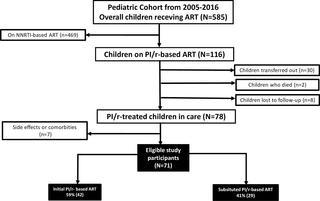Our official English website, www.x-mol.net, welcomes your
feedback! (Note: you will need to create a separate account there.)
Outcomes of protease inhibitor-based antiretroviral therapy amongst children and associated-factors in Yaoundé, Cameroon.
PLOS ONE ( IF 2.9 ) Pub Date : 2019-03-18 , DOI: 10.1371/journal.pone.0213900 Anne Esther Njom Nlend 1, 2, 3 , Cathya Ornella Guessong 2 , Annie Carole Nga Motaze 1 , Claudian Soffo 3 , Paul Olivier Koki Ndombo 4, 5 , Lionel Tsambang 2 , Joseph Fokam 4, 6, 7
PLOS ONE ( IF 2.9 ) Pub Date : 2019-03-18 , DOI: 10.1371/journal.pone.0213900 Anne Esther Njom Nlend 1, 2, 3 , Cathya Ornella Guessong 2 , Annie Carole Nga Motaze 1 , Claudian Soffo 3 , Paul Olivier Koki Ndombo 4, 5 , Lionel Tsambang 2 , Joseph Fokam 4, 6, 7
Affiliation

|
BACKGROUND
There are limited data on protease inhibitor (PI)-based antiretroviral therapy (ART) amongst children in resource-limited settings, for informing on optimal paediatric regimens.
OBJECTIVE
To evaluate therapeutic response to PI-based ART amongst HIV-infected Cameroonian children.
METHODS
A retrospective study was conducted amongst children aged 2-18 years receiving a PI-based ART at the Essos Hospital Centre (EHC), Yaounde, Cameroon. Primary end points were therapeutic success on PI-based ART, defined as clinical success (WHO I/II clinical stage), immunological success (CD4 ≥ 500/mm3) and viral suppression (viral load [VL]<1000 copies/ml). Factors associated with therapeutic success were assessed in uni- and multivariate analysis using SPSS software v.2.0; with p<0.05 considered statistically significant.
RESULTS
A total of 71 eligible children on PI-based ART were enrolled (42 on initial and 29 on substituted regimens), with a median age of 8 [IQR: 5-12] years and mean duration on ART of 7 years. Following therapeutic responses, all (100%) experienced clinical success, 95.2% experienced immunological success (91.7% on initial and 97.2% on substituted PI/r-based regimens) and 74.7% viral suppression. In univariate analysis, viral suppression was associated with: younger age (p<0.0001), living with parents as opposed to guardians (p = 0.049), and the educational level (p<0.0001). In multivariate analysis, only the age ranges of 10-14 years (OR: 0.22 [0.07-0.73]) and 15-18 years (OR: 0.08 [0.02-0.57]), were determinants of poor viral suppression.
CONCLUSION
Among these Cameroonian children, PI-based ART confers favourable clinical and immunological outcomes. The poor rate of viral suppression was mainly attributed to adolescence (10-18 years).
中文翻译:

喀麦隆雅温得儿童及相关因素中基于蛋白酶抑制剂的抗逆转录病毒治疗的结果。
背景技术在资源有限的儿童中,基于蛋白酶抑制剂(PI)的抗逆转录病毒疗法(ART)的数据有限,无法提供最佳的儿科治疗方案。目的评估在HIV感染的喀麦隆儿童中对基于PI的ART的治疗反应。方法对喀麦隆雅温得埃索斯医院中心(EHC)接受基于PI的抗逆转录病毒疗法的2-18岁儿童进行回顾性研究。主要终点是基于PI的ART的治疗成功,定义为临床成功(WHO I / II临床阶段),免疫学成功(CD4≥500 / mm3)和病毒抑制(病毒载量[VL] <1000拷贝/ ml)。使用SPSS软件v.2.0在单变量和多变量分析中评估了与治疗成功相关的因素。p <0.05被认为具有统计学意义。结果共有71名符合PI的抗逆转录病毒治疗的儿童入组(初始时42例,替代疗法29例),中位年龄为8 [IQR:5-12]岁,平均ART病程为7年。接受治疗后,所有患者(100%)均获得临床成功,免疫学成功率达95.2%(初始PI / r方案为91.7%,基于PI / r替代方案为97.2%)和病毒抑制率为74.7%。在单变量分析中,病毒抑制与以下因素有关:年龄较小(p <0.0001),与父母同住而不是与监护人住在一起(p = 0.049)和受教育程度(p <0.0001)。在多变量分析中,只有10-14岁(OR:0.22 [0.07-0.73])和15-18岁(OR:0.08 [0.02-0.57])的年龄范围是病毒抑制不良的决定因素。结论在这些喀麦隆儿童中,基于PI的抗逆转录病毒疗法具有良好的临床和免疫学效果。病毒抑制率低主要归因于青春期(10-18岁)。
更新日期:2019-03-19
中文翻译:

喀麦隆雅温得儿童及相关因素中基于蛋白酶抑制剂的抗逆转录病毒治疗的结果。
背景技术在资源有限的儿童中,基于蛋白酶抑制剂(PI)的抗逆转录病毒疗法(ART)的数据有限,无法提供最佳的儿科治疗方案。目的评估在HIV感染的喀麦隆儿童中对基于PI的ART的治疗反应。方法对喀麦隆雅温得埃索斯医院中心(EHC)接受基于PI的抗逆转录病毒疗法的2-18岁儿童进行回顾性研究。主要终点是基于PI的ART的治疗成功,定义为临床成功(WHO I / II临床阶段),免疫学成功(CD4≥500 / mm3)和病毒抑制(病毒载量[VL] <1000拷贝/ ml)。使用SPSS软件v.2.0在单变量和多变量分析中评估了与治疗成功相关的因素。p <0.05被认为具有统计学意义。结果共有71名符合PI的抗逆转录病毒治疗的儿童入组(初始时42例,替代疗法29例),中位年龄为8 [IQR:5-12]岁,平均ART病程为7年。接受治疗后,所有患者(100%)均获得临床成功,免疫学成功率达95.2%(初始PI / r方案为91.7%,基于PI / r替代方案为97.2%)和病毒抑制率为74.7%。在单变量分析中,病毒抑制与以下因素有关:年龄较小(p <0.0001),与父母同住而不是与监护人住在一起(p = 0.049)和受教育程度(p <0.0001)。在多变量分析中,只有10-14岁(OR:0.22 [0.07-0.73])和15-18岁(OR:0.08 [0.02-0.57])的年龄范围是病毒抑制不良的决定因素。结论在这些喀麦隆儿童中,基于PI的抗逆转录病毒疗法具有良好的临床和免疫学效果。病毒抑制率低主要归因于青春期(10-18岁)。











































 京公网安备 11010802027423号
京公网安备 11010802027423号